Words and photos courtesy of blackvitzrs
First Impression:
The topic of AUTOart going composite has been beaten to death and I too have shared my opinion on a few occasions; bashing their new composite model cars. In particular, I was very critical of the P1 when it was first released. Its toy like engine, the horrible shut-lines, and the painted LED strip on the headlights leave very little to desire. Why did I buy this now? Only because of the subject matter did I give in to AUTOart’s composite P1. My first impression of it in the flesh was actually a pleasant surprise. It is not as heavy as some of my diecast models, but it does not completely feel like a $20 plastic toy car. It is not as flimsy as some had said. Yes, it is flimsy, but not much worst than the diecast TSM P1.
The TSM, on the other hand, had a great first impression just due to its sheer heaviness. It is at least 25% heavier than AUTOart’s. I was also awed by the Amethyst Black, which shines a deep purple when well lit.

Accuracy and shape:
Both are very very similar in dimension, and shape. The TSM looks more muscular because of it stances lower. The fact that it is made of metal, all the panels are thicker, giving it the impression that it is bulkier and less refined. Also, if you look very closely, the shoulder bulges on the TSM on the front and the rear are ever so slightly sharper and a tad higher than the AUTOart. This is the main reason why the TSM looks more muscular in the flesh.
Paintwork:
I have seen some of the paintwork by AUTOart on plastic / composite bodies. I have not been impressed. It looks dull and boring and just does not reflect light the way metal does. The P1, however, much better painted wise than the others I have seen. Even though it is reflective and shiny, it still looks somewhat plastic. I prefer paint on metal. Color-wise, I love both the Volcano Orange and the Amethyst Black equally. Hence, colorwise, it is a tie.

Details:
Each has its own pros and cons. The headlights on the TSM are a disaster. Not only is it not accurate, the design/execution of the plastic piece is chunky and not refined at all. Note, the real P1 has two different sets of the headlight housing. One of the housings has a reflector section at the inside, a rectangular LED strip in the middle, and a circular projector housing at the very outside edge. It also has a LED strip that runs the length of the housing on top. The other housing has a projector housing towards the middle of the car, then a rectangular LED strip in the middle and a circular projector housing at the very edge.
TSM only has two circular pieces in the middle stuck together. The LED strip on the top is not defined either. The headlights on the
AUTOrt’s headlights are not much better. There are at least three sections, although each looks like a dot with no details whatsoever. The LED strip is painted over the lens, which is a disaster in and of itself. Even though they improved it by painting it thinner than the first release, it still is not ideal.
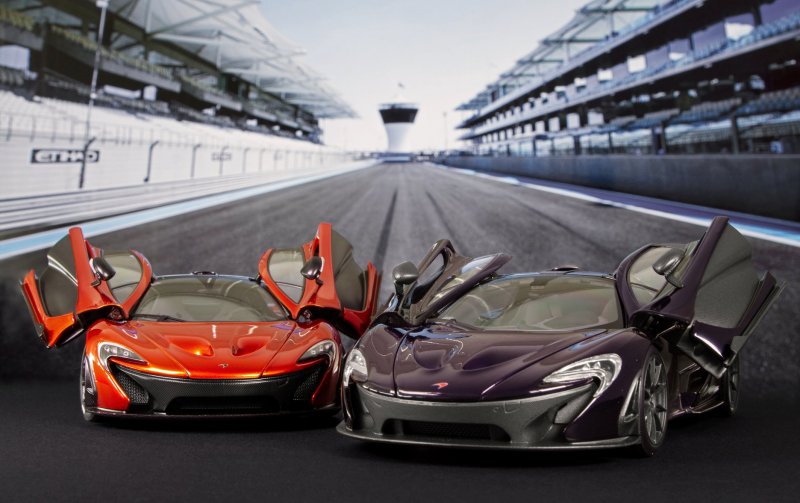
The carbon weave on the AUTOart looks better on the exterior of the car, but the carbon weave used on the interior the
The wheels and the brakes are better on the AUTOart. The brake rotor on the TSM looks like a plastic dish because of its smooth silver paint. The spoke of the rims on the TSM is very thin and detailed, but the rear wheel lacks the concaveness. AUTOart did a better job.
Stance wise, I like how the TSM sits lower in the front. However, at the back, the TSM exhibits slight positive camber while the AUTOart has negative camber. In my opinion, they should balance out each other and have the rear wheels sit flush to the fender with no camber.
Shut-lines and gaps are close between the two. I think TSM actually has better shut-line where the front bonnet meets the door. Having said that, AUTOart did improve a lot over their first release of the P1 where absolutely nothing aligned on most of the examples.
Overall, the AUTOart is more refined. There is mesh under the front air lower ducts and under the opening in the front bonnet. The mesh on the back is finer as well. Even though I think the TSM looks better with the larger honeycomb mesh at the back.
Quality control and what I don’t like:
Quality control on both is iffy. Because I bought the TSM P1 used, I can’t complain too much.
On the TSM, there is a small part missing on the carbon weave on the front lip. Carbon weave on the rear right triangle window is not applied properly. Doors do stay open but one side clicks on one side does not. One side opens higher than the other. The operation is very fragile. I will not be opening it ever again. On my example, the wheels do not steer. There are a couple of small paint chips but at least they are not in obvious places. My biggest gripe against TSM is their choice of material for the clear plastic window. They are Hotwheels quality. They are not smooth and completely clear. If you have a TSM diecast, look closely and you will notice ripples throughout, wavy and a tad translucent. AUTOart’s use of material for the clear windows is second to none.
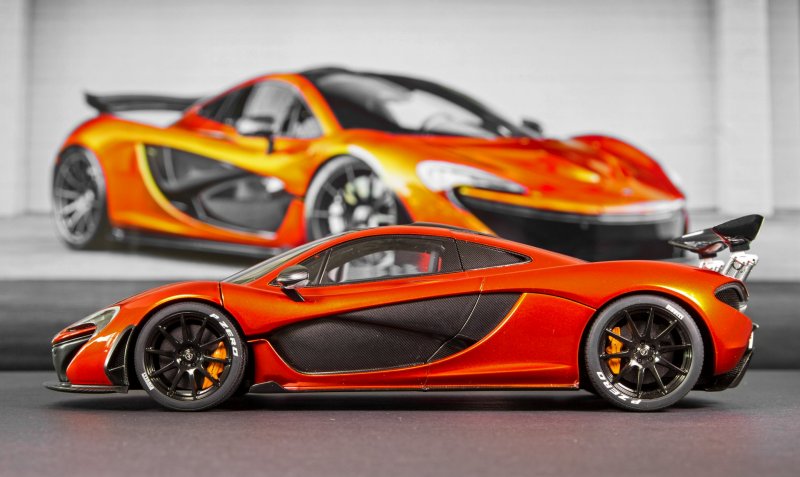
On my AUTOart example, the paint is not completely clean, has slight black specs that are stuck in the paint. There is slight paint runs on a few of the edges. There are minimal paint chips, especially where the left door meets the bonnet. The left door is slightly misaligned with the rear engine cover at the top. The biggest flaw is the little triangle piece between the windshield and the front left door at the top (where the hinge of the door is) does not sit flush to the windshield. If you look closely at the photos it is stuck upwards. Needless to say, this model is getting returned.
On the AUTOart, I obviously don’t like that it is plastic. I don’t like the engine. My biggest concern is the operation of the rear spoiler. On my example, one of the struts is tight but the other is extremely loose. I couldn’t even fit the spoiler into the strut. I had to use TSM stationery wing on the AUTOart. The spoiler, should it install properly stands lower than the TSM. I like how TSM’s wing sits so high.
Price:
I am not going there as both models cost a substantial amount nowadays. I should’ve bought the TSM P1 when it first came out. It is now very rare and the price has skyrocketed. As for AUTOart, being plastic it should cost half of what it retails for.
Overall, I am actually more impressed with the AUTOart. Aside from it being plastic and the wing sitting so low when propped, I think it is the better-made model.



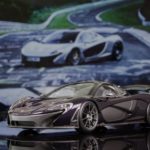

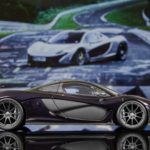
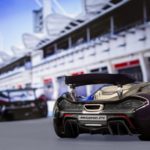


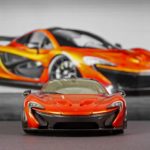

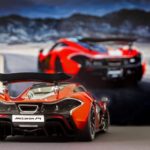



It seems like the inherent flaws in each of these makes them a rather poor value.
I have returned 2 Autoart Mclaren P1’s already. Black residue in the orange paint, paint chips, glue residue and 1 even had the front bonnet not mounted properly. The top of the hood stood out from the chassis.
Very poor for this price range, I will try and buy 1 more P1 but if that one has flaws too I will stick to my Minichamps P1.
Nice evolution of modelling business – we are offered to choose between bad and worse :)
Can you let us have the complete text content in the paragraph which talks about carbon weave. I don’t know about other people’s understanding & comprehension of it but it doesn’t sound right to me
The carbon weave on the AUTOart looks better on the exterior of the car. However, the carbon detailing on the interior the TSM has better details. The entire carbon tub is finished in carbon fibre on the TSM including the door sills. Autoart missed the carbon detailing here. Overall, TSM’s carbon detailing on the interior looks more substantial than Autoart.
I wrote the review at 2am, so not surprising it might have been harder to comprehend and I might have missed a point here or there.
If you were a modeller, you would understand that your statement about the paint is complete nonsense. The quality of a paint job depends on preparation of material, the skills of the painter and the quality of the paint. It does NOT depend on the material itself. If you’re suggesting that the metal shines through the paint, it would be a terrible paint job in terms of quality. If the paint on this model looks bad, it would be so because AA did a bad job, not because of the plastic.
@Moondawn: I think I know what is the real reason. I noticed that on mine models. At first I haven’t realized that one of them was composite (AA Lambo GT3 FL2). Maybe because it was long time in the box and then I was very quickly putting it on shelf… But I felt it shines differently than others. More like the plastic Lambo Aventador SV, which is composite and I knew it at the moment of buying it. Then I realized that it is too light for die-cast and then I noticed “composite” sticker on the box.
I looked on those composite and die-cast models for quite some time and I think I know the reason. Unfortunately, plastic is not that even surface. It always have some curvy but very shallow dips. Especially near the edges. Contrary to composite, die cast is rather always well defined near to edges. What it causes? Shines/reflections on painted composite have the same magnitude and shade as on die-cast, but different shapes. Shines/reflections on die-cast have sharper edges and well defined shapes, while on composite those shines are wavy, curvy, amorphic etc. especially near the edges.
I think our brains have learned through all these years how processing imperfections impact light reflections / shining on different materials. Those processing imperfections are specific to certain type of material – like for ABS/plastic and metal. I think it may be related to cooling down of both materials and how evenly they solidify during this process. Metal has better thermal conductivity and has very uniform viscosity over its whole volume, thus it cools down very uniformly on whole its surface, which causes that whole surface is also very uniform after process ends. ABS and other plastics are not that uniform in terms of viscosity and have lower thermal conductivity. So it happens, that some places are thinner (lower viscosity at certain point) and some are thicker (higher viscosity at certain point, longer cooling down process). We see results of those imperfections (visible in that reflections/shining), that’s why we feel the difference, but sometimes we are unable to tell what is the reason for it. I also see the “plasticness” of my composite models, when they stand between their die-cast brothers.
Of course this is only my own thought process and my own experience with looking on surfaces done from different materials, mixed with some general knowledge about physical differences between materials. I am not processing / mechanical or material engineer.